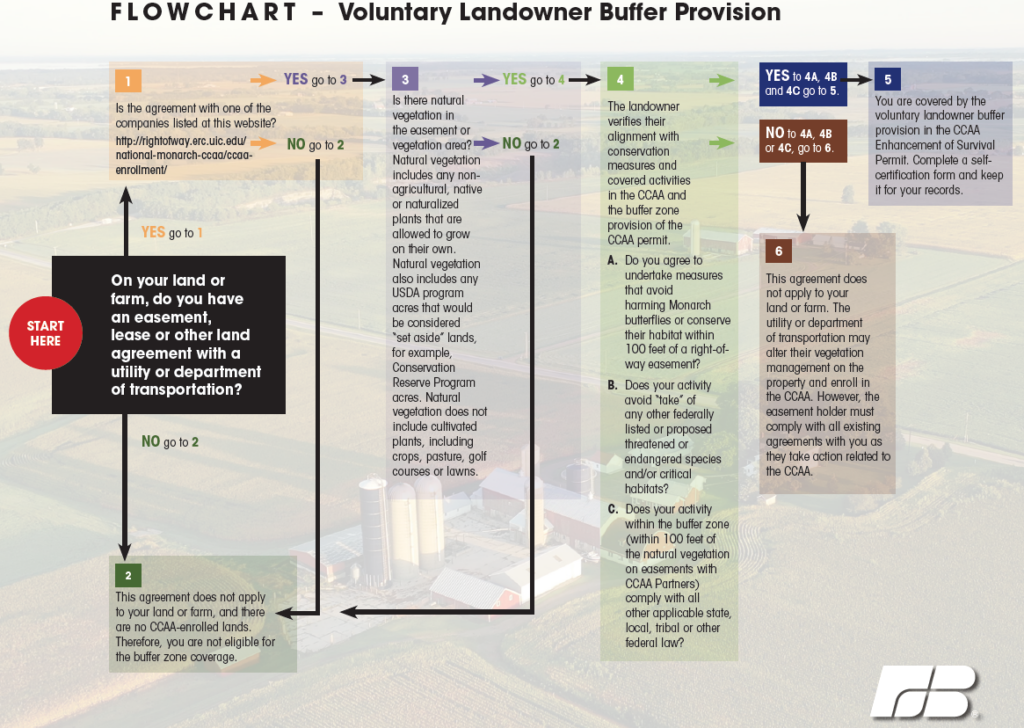Where are the monarchs now?
The monarchs are in the middle of their second generation and in their northern breeding area. They will be laying their eggs over the next couple weeks. Those off-spring will form the super generation that will undertake the trek to Mexico. Follow their migration at Journey North.
If you as a farmer have a right-of-way through your land, you may voluntarily self-certify conservation actions to receive protection against incidentally harming or harassing monarchs under an agreement between the Energy Resources Center at the University of Illinois Chicago and the U.S. Fish and Wildlife Service. The Nationwide Candidate Conservation Agreement with Assurances for Monarch Butterflies on Energy and Transportation Lands (CCAA) provides regulatory certainty for energy companies’ and transportation agencies’ ongoing activities and supports monarch conservation. It also provides a landowner buffer provision.
How does the agreement work?
An energy company or transportation agency will enroll adopted acres, which are areas within managed right-of-way on which conservation measures are applied to support monarch butterfly habitat. Landowners are then encouraged to manage land within a 100-foot buffer on either side of that adopted acreage to also support the monarch. And in return, they gain regulatory certainty against incidental take if the monarch is listed under the Endangered Species Act in the future.
Since finalized in April 2020, the monarch CCAA has received 41 applications from energy and transportation agencies spanning the U.S. The CCAA aims to create more than 2 million acres of habitat for the monarch, and a snapshot of enrolled partners’ commitment to creating habitat and successes from 2022 shows that applicants have already committed to creating more than 820,000 acres across the U.S.
Farmers, ranchers and other landowners who have an enrolled right-of-way through their property are eligible to participate in the CCAA Landowner Buffer Provision for monarch butterflies. Upon successful completion of the self-certification process, landowners receive incidental-take coverage of monarchs, if they are determined to be listed, on eligible lands under the buffer provision of the agreement.

What does self-certification cover on my land?
Landowner participation in the CCAA is voluntary. If a landowner opts to take no action, the energy or transportation organization that manages vegetation on the right-of-way may enroll lands and receive assurances, i.e., regulatory protection. This agreement does not impact existing easement agreements and therefore the energy or transportation organization will not violate the easement to participate in this CCAA agreement. Landowners who do not manage monarch habitat within the buffer area or do not self-certify do not receive regulatory protection since they did not seek incidental take coverage through the self-certification process. In this situation, they should ensure that they are not individually responsible for incidental take of monarchs on their land if this species is listed as threatened or endangered under the Endangered Species Act.
Why conserve the monarch butterfly?
Over the past two decades, monarch numbers in North America have declined. The primary drivers affecting monarch health are changes in breeding, migratory, and overwintering habitat, continued exposure to insecticides, and effects of climate change. In December 2020, the U.S. Fish and Wildlife Service determined that listing the monarch under the Endangered Species Act is warranted but did not propose listing the species at that time due to higher priority species. The Service will reevaluate the monarch’s status annually until a final listing decision is proposed in 2024.
Where do I learn more about the CCAA?
Learn more about the monarch butterfly and the Nationwide Candidate Conservation Agreement for Monarch Butterfly on Energy and Transportation Land, including the landowner guide and self-certification form. You may also contact the Pollinator Habitat Help Desk at (337) 422-4828 with questions. For more information on establishing pollinator habitat check out the BBHF Pollinator Habitat Establishment Guide.
